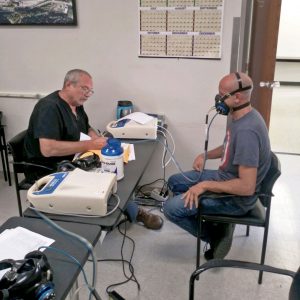On Sept. 26, OSHA issued a final rule for two new respirator fit testing protocols (for quantitative fit testing) to ensure that employee respirators fit properly. Employers can use these protocols to keep workers safe from airborne contaminants.
One of the two new protocols is the modified ambient aerosol condensation nuclei counter (CNC) qualitative fit testing for full-facepiece and half-mask elastomeric respirators (EHFRs). The other uses modified ambient aerosol CNC qualitative fit testing for filtering facepiece respirators (i.e. N-95).
These tests are variations of the original OSHA-approved protocol. They require fewer and shorter test exercises, as well as a streamlined sampling sequence.
The two new methods are commonly referred to as the PortaCount protocol.
What is Respirator Fit Testing?
OSHA requires respirator fit testing when workers are required to wear respirators at work. It ensures that an employee’s facepiece respirator fits tightly and properly.
There are two types of tests:
1) Qualitative Fit Test – a non-numeric pass/fail test that relies on the employee’s sense of taste or smell, or his/her reaction to a substance (test agent) in order to detect leakage into the respirator facepiece.
2) Quantitative Fit Test – utilizes a machine to measure the amount of leakage into the facepiece, instead of relying on senses.
Download The Respirator Refresher Safety Training Guide Here
What is the PortaCount Protocol?
The PortaCount protocol uses a series of eight exercises to test respirator fit.
The test exercises are performed in the following order:
- Normal breathing,
- deep breathing,
- turning the head from side to side,
- moving the head up and down,
- talking, grimacing,
- bending over,
- and then a final normal breathing test.
Compared to the original ambient aerosol CNC protocol, it includes only three of the original test exercises. This reduces the total test duration from 7.2 to 2.5 minutes. Of course, it should be noted that this is PortaCount specific, and for quantitative fit testing only.
What Does This Mean for Employers?
These new protocols are seen as alternatives that give you greater quantitative fit testing flexibility, and that make it easier to comply with the respiratory protection standard.
However, you are not required to update or replace your current methods for fit-testing.
Related: Respirator Seal Checks Essential for Workers
With the addition of these two methods, OSHA now has six respirator fit-testing protocols to help protect employees from hazardous respirable contaminants. You’ll find all of the respirator fit-testing protocols in Appendix A of OSHA’s Respiratory Protection Standard.
The new rule is effective immediately.
The OSHA Respiratory Standard
Employers are required, under OSHA Regulation 29 CFR 1910.134(f)(2), to ensure that an employee using a tight-fitting facepiece respirator is fit tested prior to initial use of the respirator.
Related: Are You Forgetting This Key Part to the Respirator Standard?
Employers must also fit test whenever a different respirator facepiece (size, style, model or make) is used, and at least annually thereafter.
On-site Respirator Fit Testing
Even with shorter testing times, quantitative respirator fit testing still halts productivity. But, we’re here to make it easier!
With Worksite Medical on-site respirator fit testing, you’ll be able to get your team tested and back to work in no time, and with limited disruption. Whether your team works in shifts, or you need it all done at once, we will test on your terms and at your convenience.
Related: Complete Your Respirator Clearance Questionnaire Online Today For Just $25!
Are you working at a location that doesn’t have a room available? No problem! We can bring one of our mobile medical units onsite, and do everything from audiometric exams to blood work!
Schedule an appointment today, or get your free quote by calling (1-844-622-8633), emailing (info@worksitemed.com), or completing the form below!




